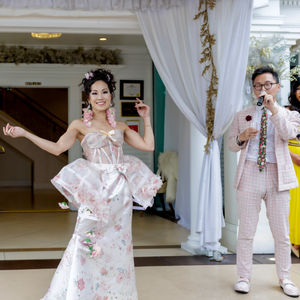
C U P
C O U T U R E
Eve Unfallen is an embodiment of myth, nature, and reclamation. The look reimagined the biblical Eve not as the fallen, but as the eternal—not cast out of Eden, but transformed into the garden itself. In this vision, Eve becomes Mother Nature—a source of growth, beauty, and nourishment, rooted in the soil of creation rather than shame.
Drawing from lingerie traditions and the romantic architecture of Victorian dress, the silhouette was both intimate and commanding. Side panniers, once symbols of excess and performance, were reinterpreted as vessels of life—adorned with cascading flowers that hung like ripe fruit from a tree. These blooms moved as the wearer walked, mimicking the gentle sway of branches in bloom. In place of breast milk, these flowers became offerings: the way a mother nourishes her child, so too does the Earth nourish us.
Sheer, diaphanous textiles layered over structured corsetry, using iterations of a unified botanical print to create a sense of dimension and duality—a tension between concealment and revelation, softness and strength. Exposed boning and strategic opacity evoked the rawness of survival and the artistry of healing. The color palette—rooted in tonal pinks—was deliberate. Pink here was not an accessory of fragility but a bold reclamation: a color of scar tissue, flesh, blooming petals, and protest.
Every seam and embellishment told a story of transformation—not destruction, but becoming. Eve Unfallen was not a return to innocence, but a celebration of experience made sacred.
This design debuted at Cup Couture: An Art Bra Soirée, a runway event celebrating the intersection of creativity, advocacy, and healing. The event raised over $107,000 for Mission Plasticos to support breast reconstruction for under- or uninsured individuals post-mastectomy, a mission championed by visionary host and lead surgeon Dr. Karen Leong. Her unwavering commitment to equitable care made the event not just a showcase of artistry, but a testament to compassion in action.
Eve Unfallen stood not only as a garment, but as a myth retold, a body reclaimed, and a garden resurrected—rooted, blooming, and defiantly alive.



















